Enhancement of Biochar Carbon Sequestration Through Mineral Regulation: Effects and Mechanisms
Abstract
1. Introduction
2. Materials and Methods
2.1. Biomass Collection and Pretreatment
2.2. Biochar Production and Characterization
2.3. Carbon Retention and Stability During Biomass Pyrolysis
2.4. Statistical Analysis
3. Results
3.1. Effect of Metal Ions and Clay Minerals on Carbon Retention Rate of Biochar
3.2. Kinetic and Thermodynamic of Pyrolysis for the Formation of Mineral-Loaded Biochar
3.3. The Mechanism of Mineral-Induced Formation of Carbon Structure in Biochar
4. Conclusions
Supplementary Materials
Author Contributions
Funding
Institutional Review Board Statement
Data Availability Statement
Acknowledgments
Conflicts of Interest
References
- Nan, H.; Mašek, O.; Yang, F.; Xu, X.; Qiu, H.; Cao, X.; Zhao, L. Minerals: A missing role for enhanced biochar carbon sequestration from the thermal conversion of biomass to the application in soil. Earth-Sci. Rev. 2022, 234, 104215. [Google Scholar] [CrossRef]
- Pstrowska, K.; Łużny, R.; Fałtynowicz, H.; Jaroszewska, K.; Postawa, K.; Pyshyev, S.; Krowiak, A. Unlocking sustainability: A comprehensive review of up-recycling biomass waste into biochar for environmental solutions. Chem. Chem. Technol. 2024, 18, 211–231. [Google Scholar] [CrossRef]
- Pyshye, S.; Lypko, Y.; Demchuk, Y.; Kukhar, O.; Korchak, B.; Pochapska, I.; Zhytnetskyi, I. Characteristics and applications of waste tire pyrolysis products: A review. Chem. Chem. Technol 2024, 18, 244–257. [Google Scholar] [CrossRef]
- Kim, H.-B.; Kim, J.-G.; Kim, T.; Alessi, D.S.; Baek, K. Interaction of biochar stability and abiotic aging: Influences of pyrolysis reaction medium and temperature. Chem. Eng. J. 2021, 411, 128441. [Google Scholar] [CrossRef]
- Nan, H.; Zhao, L.; Yang, F.; Liu, Y.; Xiao, Z.; Cao, X.; Qiu, H. Different alkaline minerals interacted with biomass carbon during pyrolysis: Which one improved biochar carbon sequestration? J. Clean. Prod. 2020, 255, 120162. [Google Scholar] [CrossRef]
- Li, F.; Cao, X.; Zhao, L.; Wang, J.; Ding, Z. Effects of mineral additives on biochar formation: Carbon Retention, stability, and properties. Environ. Sci. Technol. 2014, 48, 11211–11217. [Google Scholar] [CrossRef]
- Xiao, R.; Wang, J.J.; Gaston, L.A.; Zhou, B.; Park, J.-H.; Li, R.; Dodla, S.K.; Zhang, Z. Biochar produced from mineral salt-impregnated chicken manure: Fertility properties and potential for carbon sequestration. Waste Manag. 2018, 78, 802–810. [Google Scholar] [CrossRef]
- Li, F.; Gui, X.; Ji, W.; Zhou, C. Effect of calcium dihydrogen phosphate addition on carbon retention and stability of biochars derived from cellulose, hemicellulose, and lignin. Chemosphere 2020, 251, 126335. [Google Scholar] [CrossRef]
- Zhao, L.; Cao, X.; Zheng, W.; Scott, J.W.; Sharma, B.K.; Chen, X. Copyrolysis of biomass with phosphate fertilizers to improve biochar carbon retention, slow nutrient release, and stabilize heavy metals in soil. ACS Sustain. Chem. Eng. 2016, 4, 1630–1636. [Google Scholar] [CrossRef]
- Shen, M.; Zhu, X.; Zhang, S. Extraneous Fe increased the carbon retention of sludge-based biochar. Bull. Env. Contam. Toxicol. 2021, 106, 198–204. [Google Scholar] [CrossRef]
- Sun, C.; Tan, H.; Zhang, Y. Simulating the pyrolysis interactions among hemicellulose, cellulose and lignin in wood waste under real conditions to find the proper way to prepare bio-oil. Renew. Energy 2023, 205, 851–863. [Google Scholar] [CrossRef]
- Zhang, H.; Liu, M.; Yang, H.; Jiang, H.; Chen, Y.; Zhang, S.; Chen, H. Impact of biomass constituent interactions on the evolution of char’s chemical structure: An organic functional group perspective. Fuel 2022, 319, 123772. [Google Scholar] [CrossRef]
- Zhang, S.; Mei, Y.; Lin, G. Pyrolysis interaction of cellulose, hemicellulose and lignin studied by TG-DSC-MS. J. Energy Inst. 2024, 112, 101479. [Google Scholar] [CrossRef]
- Dong, Z.; Rene, E.R.; Zhang, P.; Hu, Q.; Ma, W. Design and Preparation of carbon material catalyst modified with metal framework and sulfonate for biochar generation from low-temperature directional pyrolysis of kitchen waste: Mechanism and performance. Bioresour. Technol. 2023, 371, 128616. [Google Scholar] [CrossRef]
- Xia, M.; Chen, Z.; Chen, Y.; Yang, H.; Chen, W.; Chen, H. Effect of Various potassium agents on product distributions and biochar carbon sequestration of biomass pyrolysis. Energy 2024, 289, 130012. [Google Scholar] [CrossRef]
- Chen, D.; Cen, K.; Zhuang, X.; Gan, Z.; Zhou, J.; Zhang, Y.; Zhang, H. Insight into biomass pyrolysis mechanism based on cellulose, hemicellulose, and lignin: Evolution of volatiles and kinetics, elucidation of reaction pathways, and characterization of gas, biochar and bio-oil. Combust. Flame 2022, 242, 112142. [Google Scholar] [CrossRef]
- Wang, W.; Lemaire, R.; Bensakhria, A.; Luart, D. Review on the catalytic effects of alkali and alkaline earth metals (AAEMs) including sodium, potassium, calcium and magnesium on the pyrolysis of lignocellulosic biomass and on the co-pyrolysis of coal with biomass. J. Anal. Appl. Pyrolysis 2022, 163, 105479. [Google Scholar] [CrossRef]
- Yang, F.; Zuo, X.; Yang, H.; Ke, Q.; Huang, Y.; Cao, X.; Zhao, L. Ionic liquid-assisted production of high-porosity biochar with more surface functional groups: Taking cellulose as attacking target. Chem. Eng. J. 2022, 433, 133811. [Google Scholar] [CrossRef]
- Yang, F.; Zhao, L.; Gao, B.; Xu, X.; Cao, X. The interfacial behavior between biochar and soil minerals and its effect on biochar stability. Environ. Sci. Technol. 2016, 50, 2264–2271. [Google Scholar] [CrossRef]
- Guo, X.; Xu, Z.; Zheng, X.; Jin, X.; Cai, J. Understanding pyrolysis mechanisms of corn and cotton stalks via kinetics and thermodynamics. J. Anal. Appl. Pyrolysis 2022, 164, 105521. [Google Scholar] [CrossRef]
- Cai, J.; Alimujiang, S. Kinetic analysis of wheat straw oxidative pyrolysis using thermogravimetric analysis: Statistical description and isoconversional kinetic analysis. Ind. Eng. Chem. Res. 2009, 48, 619–624. [Google Scholar] [CrossRef]
- Trache, D.; Abdelaziz, A.; Siouani, B. A Simple and linear isoconversional method to determine the pre-exponential factors and the mathematical reaction mechanism functions. J. Therm. Anal. Calorim. 2017, 128, 335–348. [Google Scholar] [CrossRef]
- Luo, L.; Zhang, Z.; Li, C.; He, F.; Zhang, X.; Cai, J. Insight into master plots method for kinetic analysis of lignocellulosic biomass pyrolysis. Energy 2021, 233, 121194. [Google Scholar] [CrossRef]
- Cai, J.; Yao, F.; Yi, W.; He, F. New temperature integral approximation for nonisothermal kinetics. AIChE J. 2006, 52, 1554–1557. [Google Scholar] [CrossRef]
- Deng, C.; Cai, J.; Liu, R. Kinetic analysis of solid-state reactions: Evaluation of approximations to temperature integral and their applications. Solid. State Sci. 2009, 11, 1375–1379. [Google Scholar] [CrossRef]
- Ahmad, M.; Ahmad, M.; Usman, A.R.A.; Al-Faraj, A.S.; Abduljabbar, A.; Ok, Y.S.; Al-Wabel, M.I. Date palm waste-derived biochar composites with silica and zeolite: Synthesis, characterization and implication for carbon stability and recalcitrant potential. Env. Geochem. Health 2019, 41, 1687–1704. [Google Scholar] [CrossRef]
- Liu, Y.; Gao, C.; Wang, Y.; He, L.; Lu, H.; Yang, S. Vermiculite modification increases carbon retention and stability of rice straw biochar at different carbonization temperatures. J. Clean. Prod. 2020, 254, 120111. [Google Scholar] [CrossRef]
- Ren, N.; Tang, Y.; Li, M. Mineral additive enhanced carbon retention and stabilization in sewage sludge-derived biochar. Process Saf. Environ. Prot. 2018, 115, 70–78. [Google Scholar] [CrossRef]
- Leijenhorst, E.J.; Wolters, W.; Van De Beld, L.; Prins, W. Inorganic element transfer from biomass to fast pyrolysis oil: Review and experiments. Fuel Process. Technol. 2016, 149, 96–111. [Google Scholar] [CrossRef]
- Zhao, L.; Cao, X.; Zheng, W.; Kan, Y. Phosphorus-assisted biomass thermal conversion: Reducing carbon loss and improving biochar stability. PLoS ONE 2014, 9, e115373. [Google Scholar] [CrossRef]
- Ren, J.; Wang, F.; Zhai, Y.; Zhu, Y.; Peng, C.; Wang, T.; Li, C.; Zeng, G. Effect of sewage sludge hydrochar on soil properties and Cd immobilization in a contaminated soil. Chemosphere 2017, 189, 627–633. [Google Scholar] [CrossRef] [PubMed]
- Jarvis, K.; Carpenter, R.W.; Windman, T.; Kim, Y.; Nunez, R.; Alawneh, F. Reaction mechanisms for enhancing mineral sequestration of CO2. Environ. Sci. Technol. 2009, 43, 6314–6319. [Google Scholar] [CrossRef] [PubMed]
- Liu, W.-J.; Jiang, H.; Tian, K.; Ding, Y.-W.; Yu, H.-Q. Mesoporous carbon stabilized MgO nanoparticles synthesized by pyrolysis of MgCl2 preloaded waste biomass for highly efficient CO2 capture. Environ. Sci. Technol. 2013, 47, 9397–9403. [Google Scholar] [CrossRef] [PubMed]
- Zhu, X.; Qian, F.; Liu, Y.; Matera, D.; Wu, G.; Zhang, S.; Chen, J. Controllable synthesis of magnetic carbon composites with high porosity and strong acid resistance from hydrochar for efficient removal of organic pollutants: An overlooked influence. Carbon. 2016, 99, 338–347. [Google Scholar] [CrossRef]
- Qian, T.-T.; Li, D.-C.; Jiang, H. Thermochemical behavior of tris(2-Butoxyethyl) phosphate (TBEP) during Co-pyrolysis with biomass. Environ. Sci. Technol. 2014, 48, 10734–10742. [Google Scholar] [CrossRef]
- Qiu, B. Synthesis of industrial solid wastes/biochar composites and their use for adsorption of phosphate_from surface properties to sorption mechanism. Colloids Surf. A Physicochem. Eng. Asp. 2019, 571, 86–93. [Google Scholar] [CrossRef]
- Nie, N.; Wang, Y.; Yellezuome, D.; Liu, X.; Wang, P.; Wang, X.; Zhu, C.; Xiao, J.; Cai, J. Exploring kinetic and thermodynamic mechanisms of switchgrass pyrolysis using iterative linear integral isoconversional method and master plots approach. Fuel 2023, 338, 127266. [Google Scholar] [CrossRef]
- Li, C.; Yellezuome, D.; Li, Y.; Liu, R.; Cai, J. Enhancing bio-aromatics yield in bio-oil from catalytic fast pyrolysis of bamboo residues over bi-metallic catalyst and reaction mechanism based on quantum computing. Fuel 2023, 336, 127158. [Google Scholar] [CrossRef]
- Lu, Q.; Zhang, L.; Chen, X.; Li, K.; Meng, L.; Xie, X.; Yuan, S.; Gao, Y.; Zhou, X. Synergistic effect of volatile inherent minerals on catalytic pyrolysis of wheat straw over a Fe–Ca–Ni catalyst. Energy 2022, 253, 124216. [Google Scholar] [CrossRef]
- Saddawi, A.; Jones, J.M.; Williams, A. Influence of alkali metals on the kinetics of the thermal decomposition of biomass. Fuel Process. Technol. 2012, 104, 189–197. [Google Scholar] [CrossRef]
- Chen, J.; Wang, Y.; Lang, X.; Ren, X.; Fan, S. Evaluation of agricultural residues pyrolysis under non-isothermal conditions: Thermal behaviors, kinetics, and thermodynamics. Bioresour. Technol. 2017, 241, 340–348. [Google Scholar] [CrossRef] [PubMed]
- Collazzo, G.C.; Broetto, C.C.; Perondi, D.; Junges, J.; Dettmer, A.; Dornelles Filho, A.A.; Foletto, E.L.; Godinho, M. A detailed non-isothermal kinetic study of elephant grass pyrolysis from different models. Appl. Therm. Eng. 2017, 110, 1200–1211. [Google Scholar] [CrossRef]
- Mohan, D.; Sarswat, A.; Ok, Y.S.; Pittman, C.U. Organic and Inorganic contaminants removal from water with biochar, a renewable, low cost and sustainable adsorbent—A critical review. Bioresour. Technol. 2014, 160, 191–202. [Google Scholar] [CrossRef] [PubMed]
- Zhang, Z.; Li, Y.; Luo, L.; Yellezuome, D.; Rahman, M.M.; Zou, J.; Hu, H.; Cai, J. Insight into kinetic and thermodynamic analysis methods for lignocellulosic biomass pyrolysis. Renew. Energy 2023, 202, 154–171. [Google Scholar] [CrossRef]
- Huang, X.; Yamasaki, K.; Kudo, S.; Sperry, J.; Hayashi, J. Influence of ionic liquid type on porous carbon formation during the ionothermal pyrolysis of cellulose. J. Anal. Appl. Pyrolysis 2020, 145, 104728. [Google Scholar] [CrossRef]
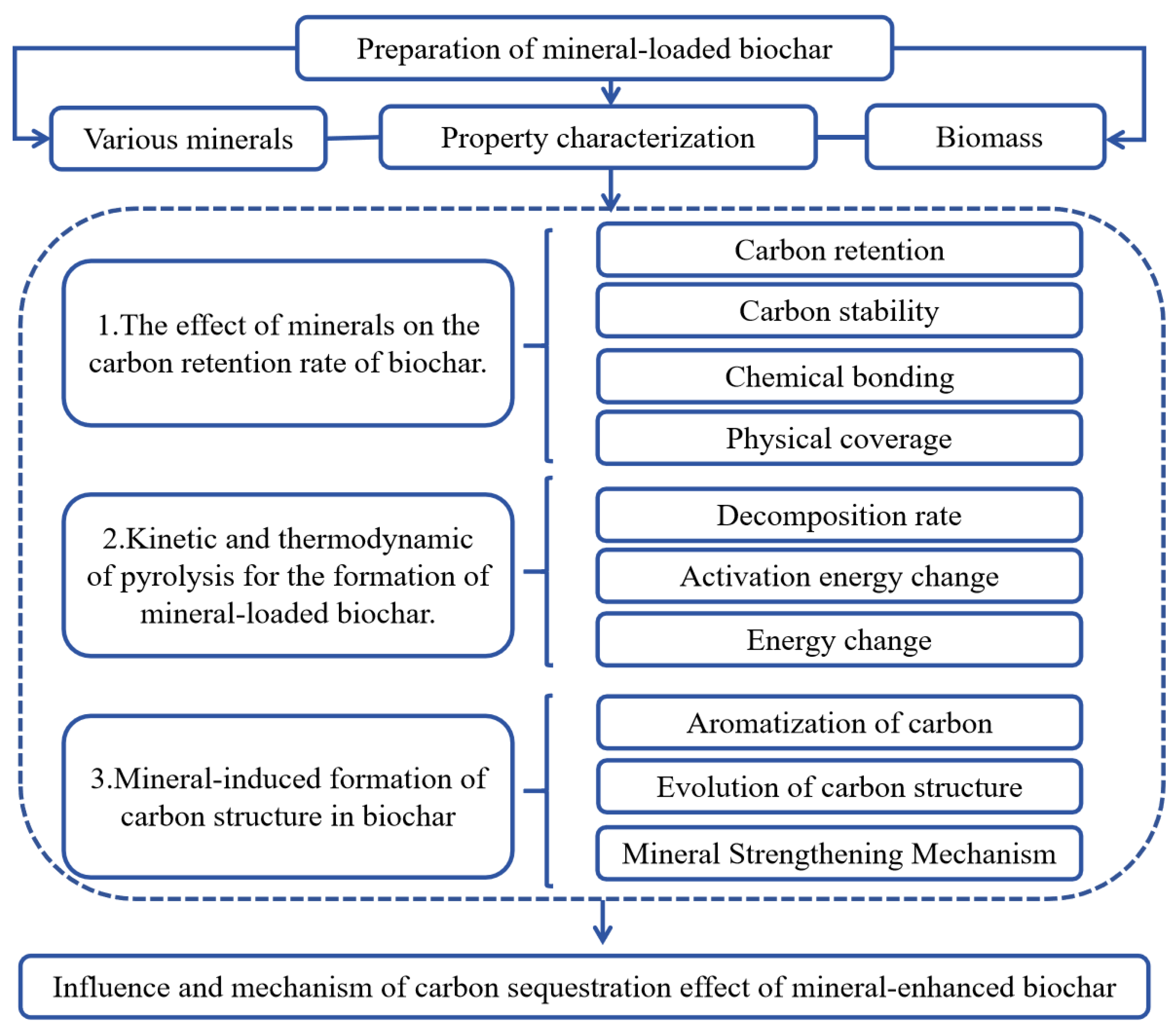
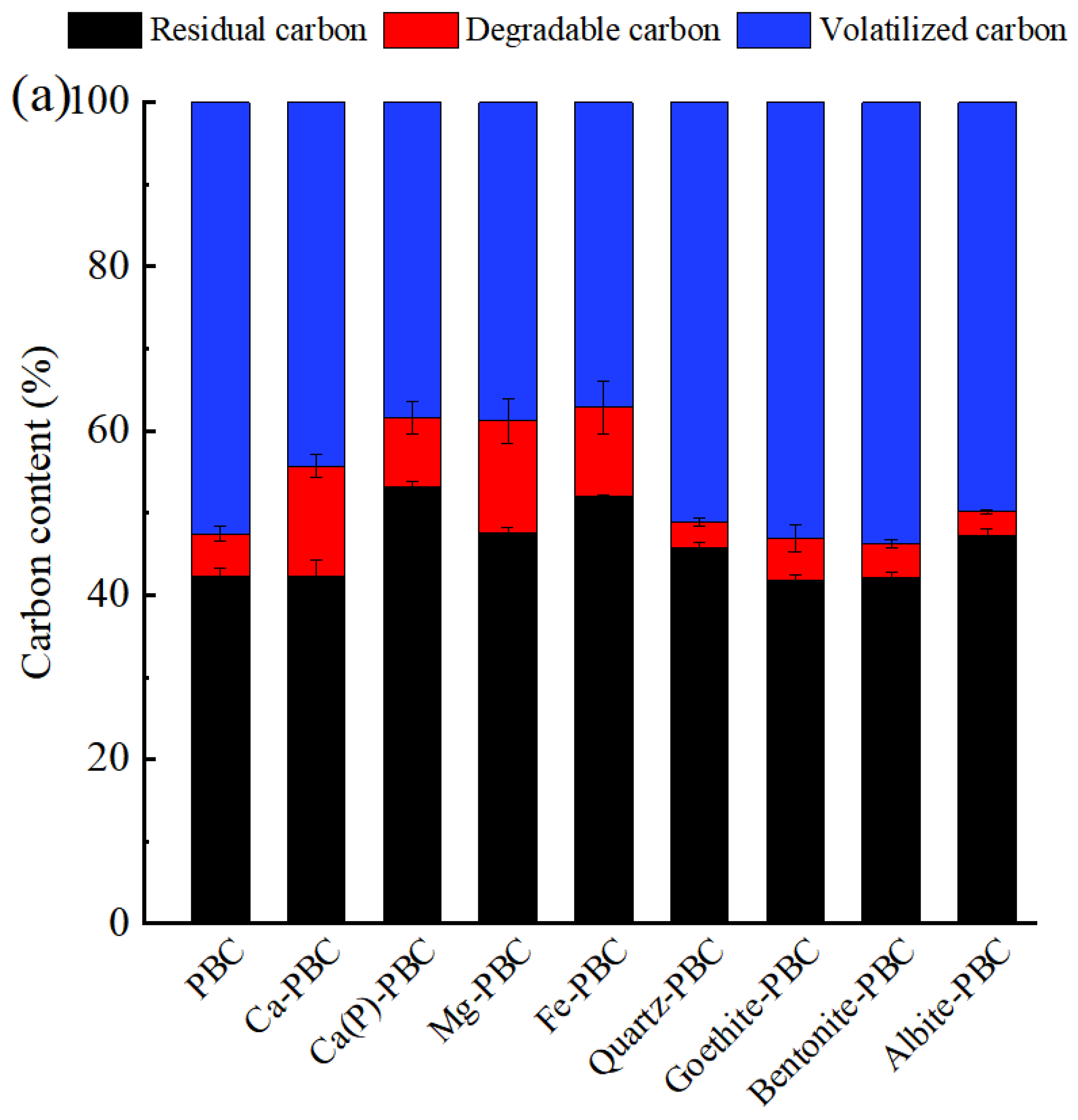
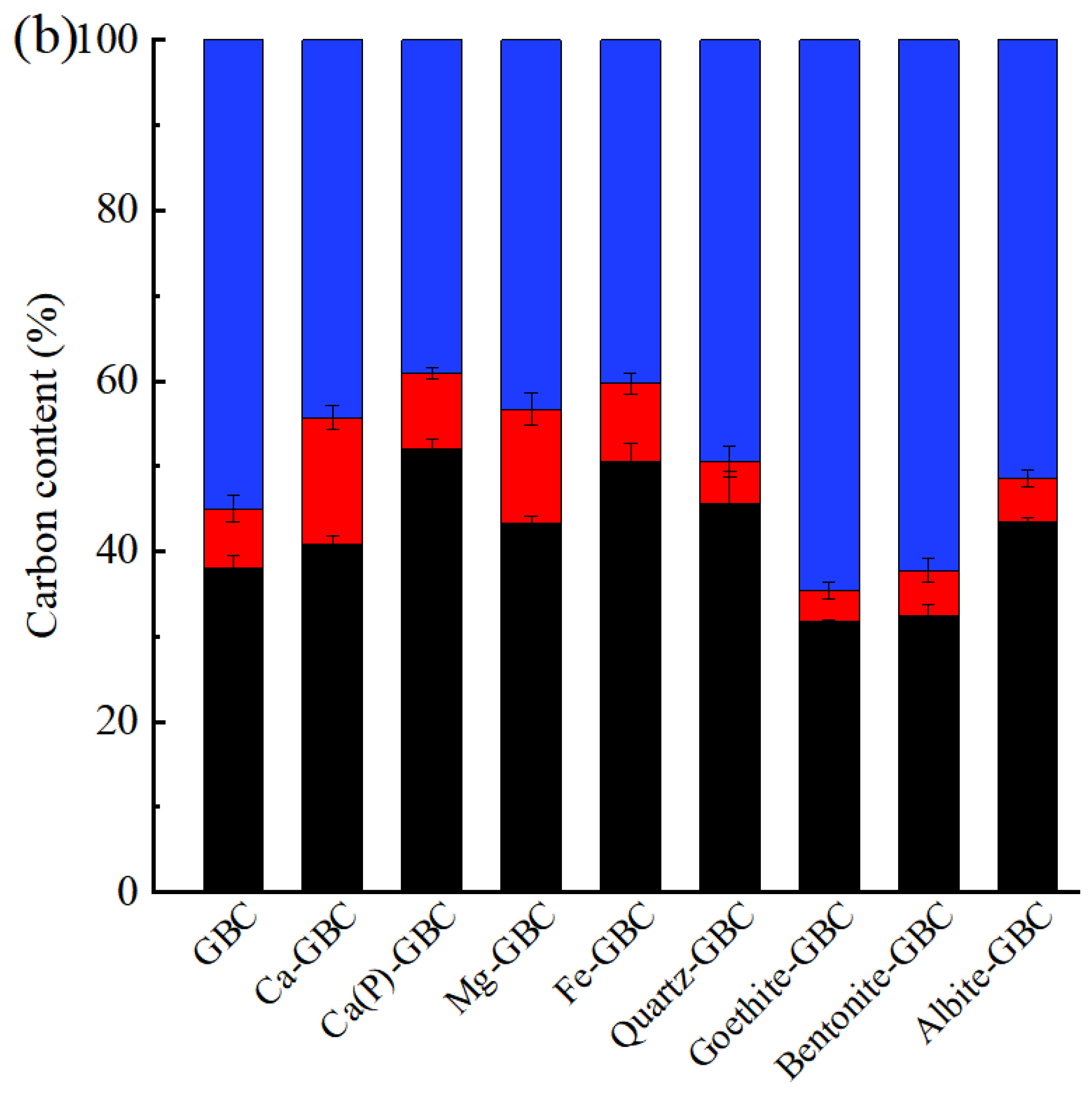
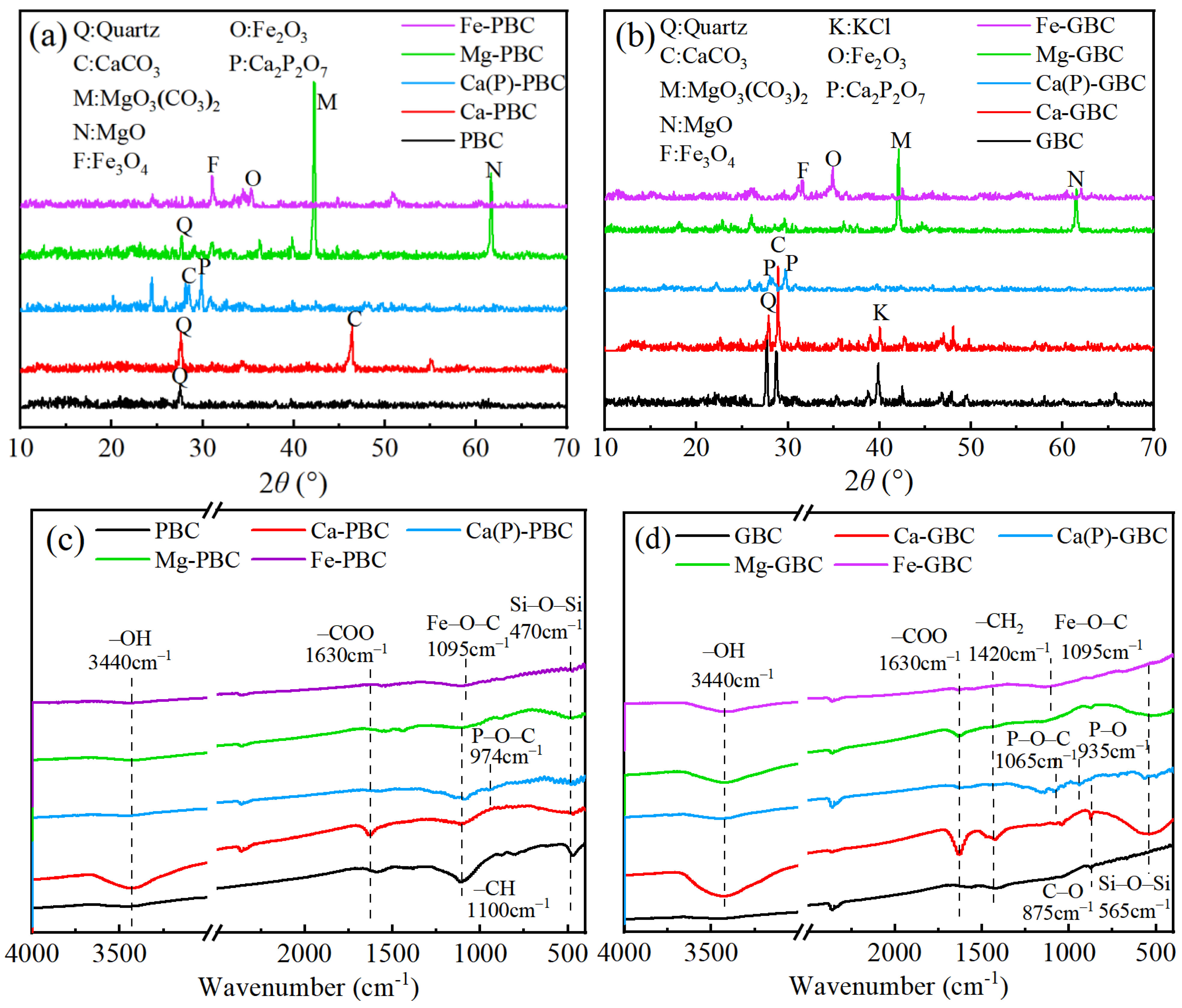
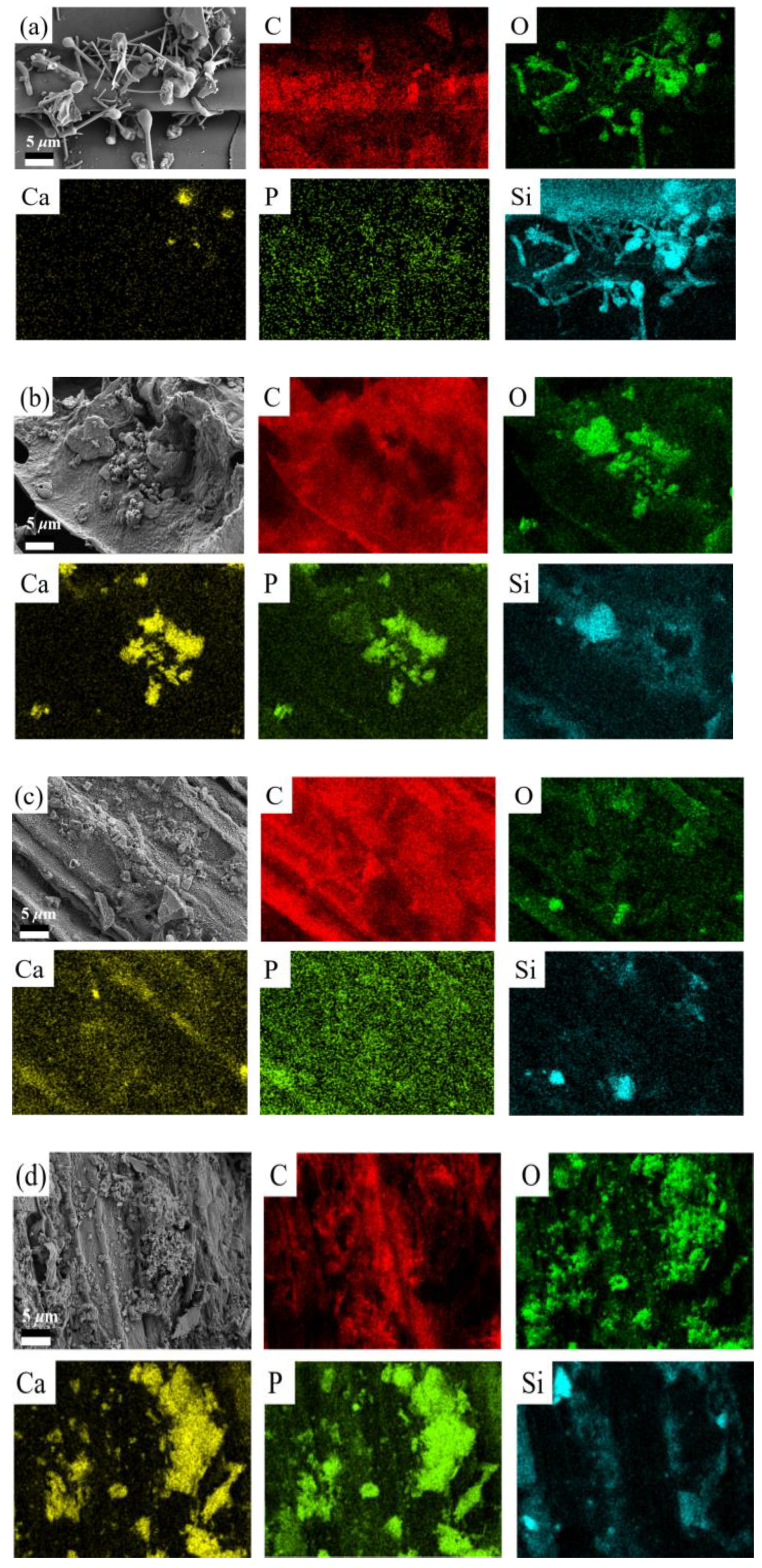
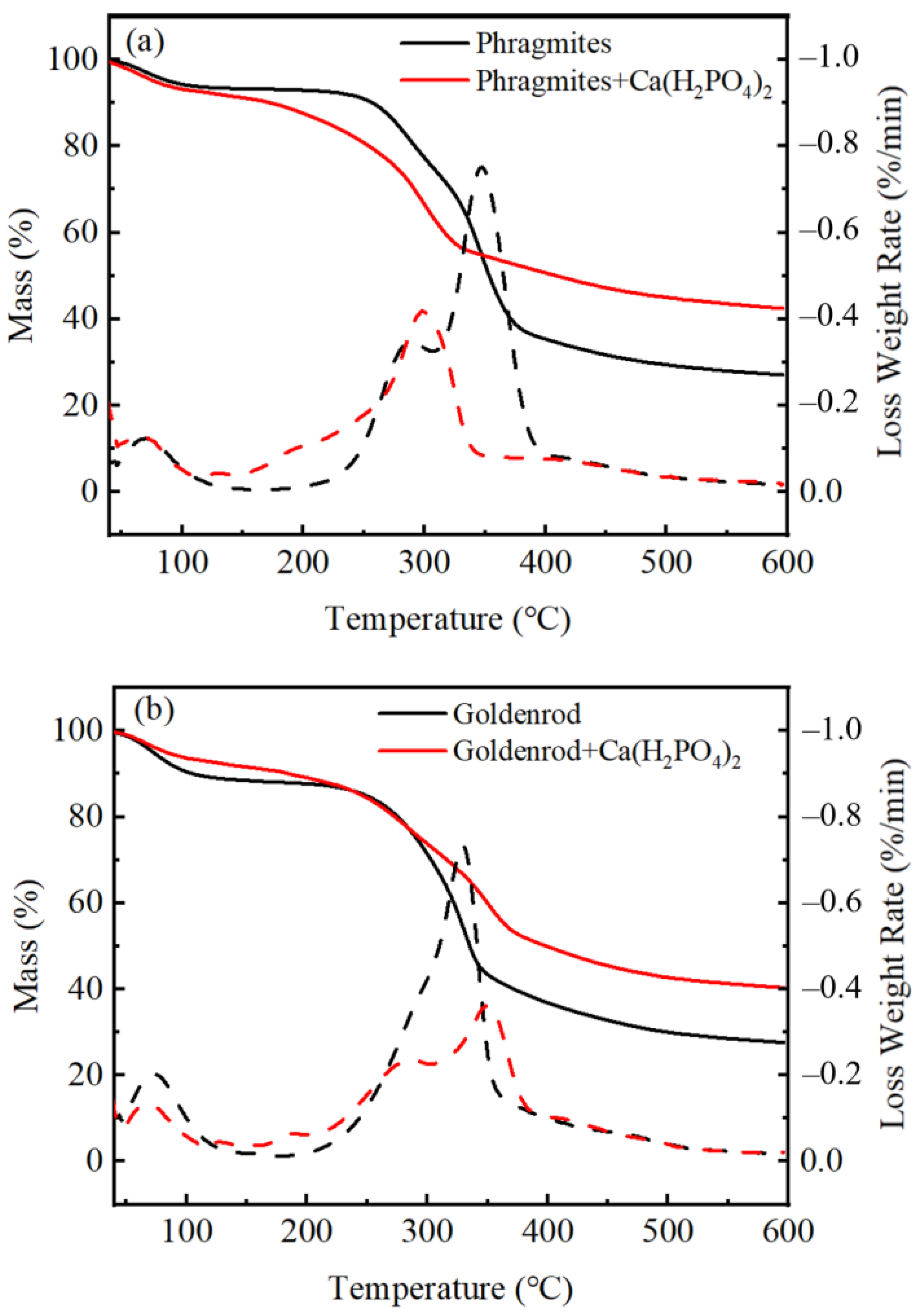
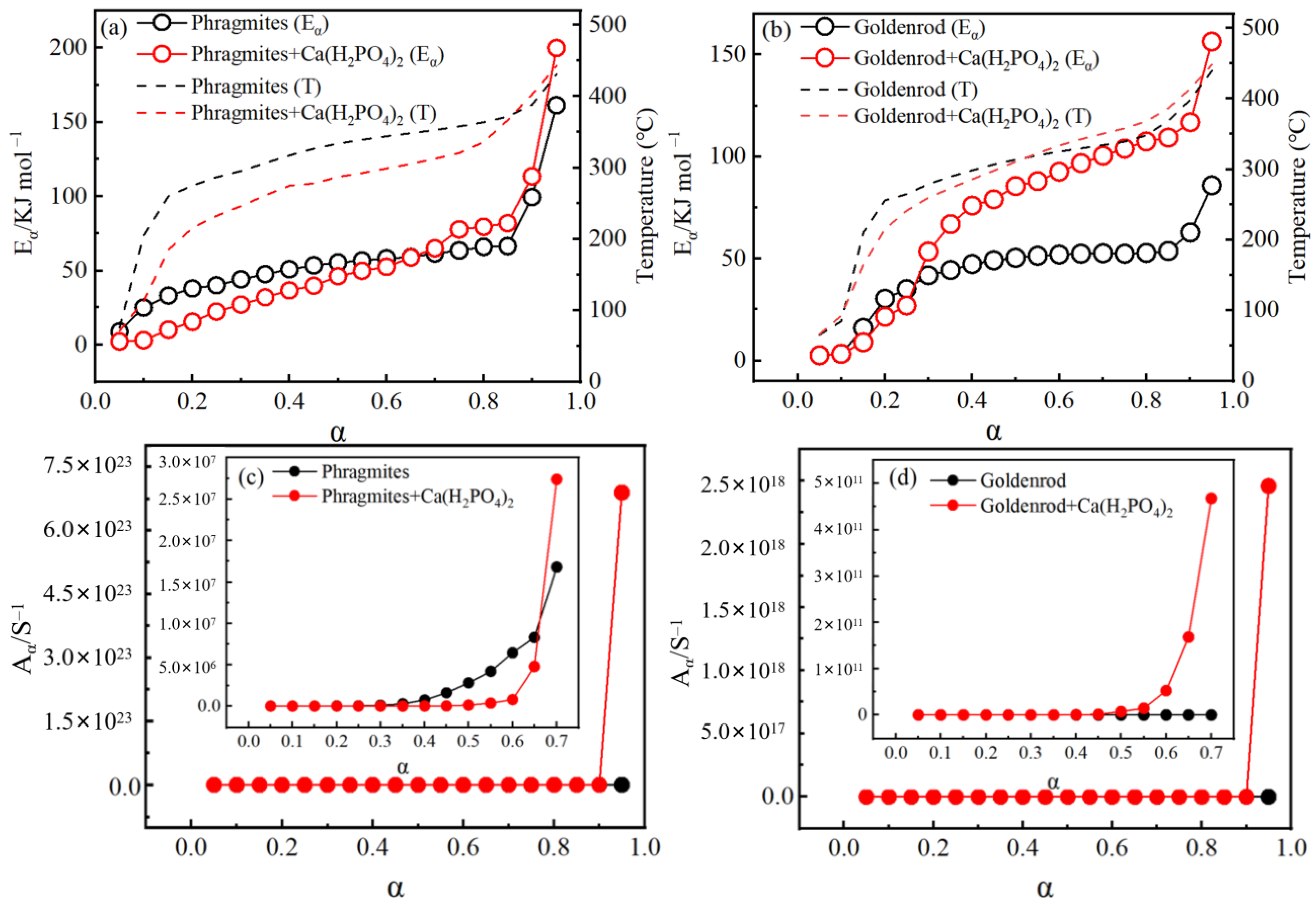

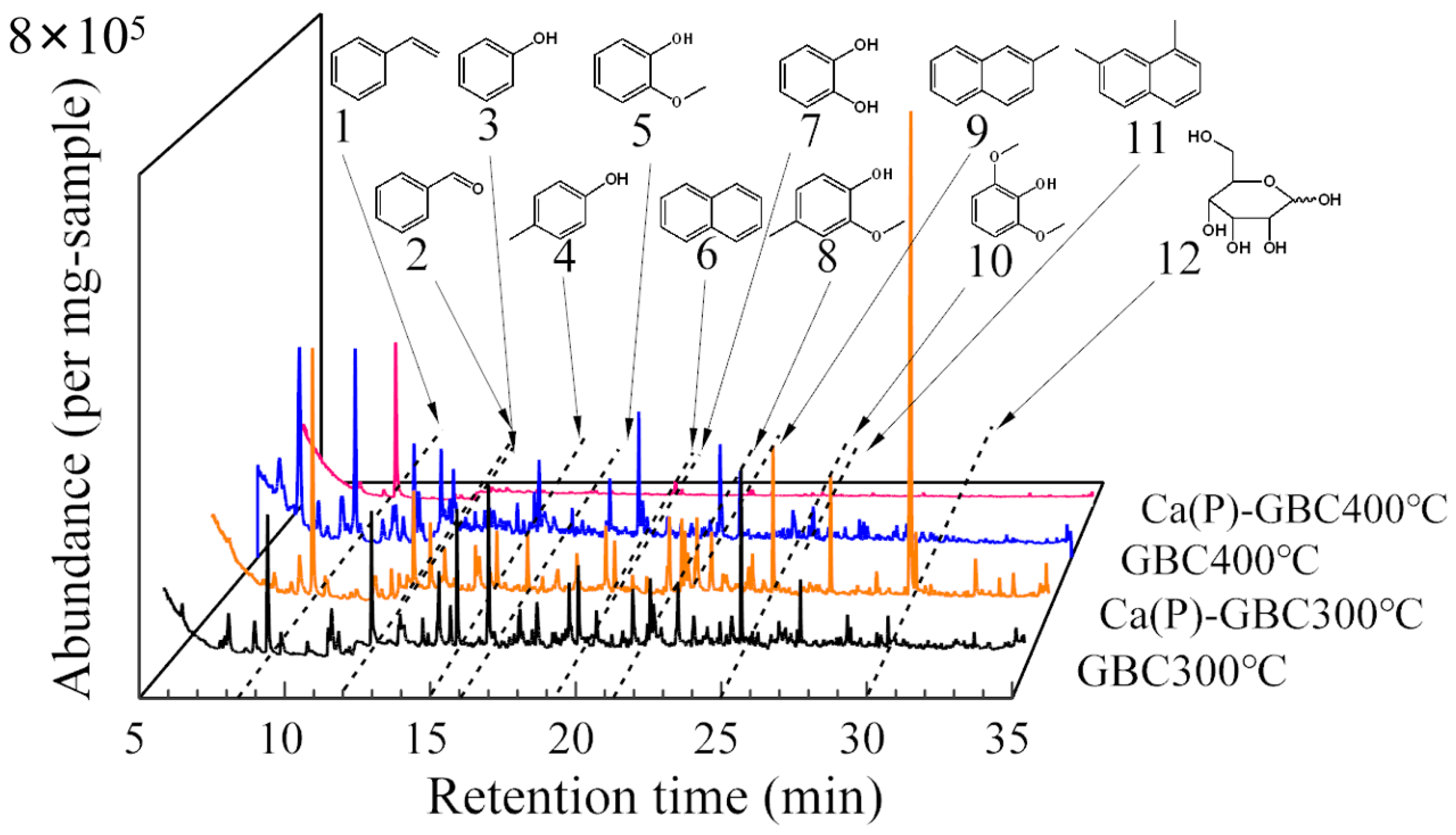

| Biochar Types | C % wt | H % wt | N % wt | S % wt | H/C | Yield % wt | pH | Ash % wt | Organic % wt |
| PBC | 71.7 | 1.39 | 0.39 | 0.09 | 0.232 | 28.6 | 7.09 | 20.4 | 79.6 |
| Ca-PBC | 46.1 | 3.47 | 0.00 | 0.01 | 0.903 | 52.3 | 7.06 | 31.7 | 68.3 |
| Ca(P)-PBC | 54.4 | 1.32 | 0.23 | 0.08 | 0.292 | 49.0 | 3.11 | 39.1 | 60.9 |
| Mg-PBC | 57.5 | 1.46 | 0.00 | 0.02 | 0.305 | 46.1 | 9.75 | 21.8 | 78.2 |
| Fe-PBC | 55.0 | 1.34 | 0.13 | 0.05 | 0.293 | 49.4 | 2.32 | 30.8 | 69.2 |
| Quartz-PBC | 45.8 | 1.17 | 0.12 | 0.00 | 0.307 | 46.1 | 10.2 | 51.0 | 49 |
| Goethite-PBC | 43.1 | 0.98 | 0.00 | 0.02 | 0.273 | 47.1 | 9.82 | 55.6 | 44.4 |
| Bentonite-PBC | 49.9 | 1.55 | 0.15 | 0.00 | 0.372 | 40.1 | 9.71 | 43.2 | 56.8 |
| Albite-PBC | 50.9 | 1.19 | 0.00 | 0.00 | 0.280 | 42.6 | 10.9 | 39.4 | 60.6 |
| GBC | 71.3 | 1.70 | 0.54 | 0.00 | 0.286 | 28.3 | 11.0 | 19.3 | 80.7 |
| Ca-GBC | 45.1 | 4.94 | 0.00 | 0.00 | 1.315 | 56.0 | 10.1 | 33.1 | 66.9 |
| Ca(P)-GBC | 54.8 | 1.33 | 0.25 | 0.00 | 0.297 | 50.4 | 3.60 | 39.2 | 60.8 |
| Mg-GBC | 56.4 | 2.30 | 0.00 | 0.00 | 0.488 | 45.6 | 9.68 | 29.2 | 70.8 |
| Fe-GBC | 54.2 | 1.89 | 0.43 | 0.00 | 0.418 | 49.9 | 2.76 | 29.7 | 70.3 |
| Quartz-GBC | 50.1 | 1.07 | 0.00 | 0.00 | 0.256 | 45.8 | 11.1 | 48.1 | 51.9 |
| Goethite-GBC | 34.4 | 0.99 | 0.16 | 0.00 | 0.346 | 46.7 | 10.7 | 57.3 | 42.7 |
| Bentonite-GBC | 46.5 | 1.29 | 0.27 | 0.00 | 0.332 | 36.8 | 10.8 | 48.9 | 51.1 |
| Albite-GBC | 55.1 | 1.24 | 0.31 | 0.00 | 0.270 | 40.0 | 11.3 | 37.2 | 62.8 |
| α | Goldenrod | Goldenrod + Ca(H2PO4)2 | ||||
|---|---|---|---|---|---|---|
| ∆H (KJ mol−1) | ∆G (KJ mol−1) | ∆S (J mol−1 K−1) | ∆H (KJ mol−1) | ∆G (KJ mol−1) | ∆S (J mol−1 K−1) | |
| 0.05 | 2.1 | 122.6 | −274.1 | 2.1 | 125.2 | −274.7 |
| 0.10 | 2.6 | 121.8 | −271.0 | 2.6 | 124.3 | −271.6 |
| 0.15 | 14.2 | 116.1 | −231.8 | 7.6 | 120.6 | −252.2 |
| 0.20 | 28.2 | 113.7 | −194.4 | 19.6 | 117.4 | −218.2 |
| 0.25 | 33.0 | 113.2 | −182.5 | 24.9 | 116.6 | −204.6 |
| 0.30 | 39.6 | 112.5 | −165.9 | 51.4 | 114.0 | −139.8 |
| 0.35 | 42.1 | 112.3 | −159.8 | 64.6 | 113.2 | −108.4 |
| 0.40 | 44.9 | 112.1 | −152.7 | 73.6 | 112.7 | −87.1 |
| 0.45 | 46.7 | 112.0 | −148.5 | 76.6 | 112.5 | −80.2 |
| 0.50 | 47.9 | 111.9 | −145.5 | 83.0 | 112.2 | −65.2 |
| 0.55 | 48.8 | 111.8 | −143.3 | 85.4 | 112.1 | −59.7 |
| 0.60 | 49.3 | 111.8 | −142.0 | 89.9 | 112.0 | −49.2 |
| 0.65 | 49.7 | 111.7 | −141.0 | 94.0 | 111.8 | −39.8 |
| 0.70 | 49.9 | 111.7 | −140.5 | 97.6 | 111.7 | −31.4 |
| 0.75 | 49.7 | 111.7 | −141.1 | 101.0 | 111.5 | −23.6 |
| 0.80 | 49.9 | 111.7 | −140.5 | 104.4 | 111.4 | −15.7 |
| 0.85 | 50.7 | 111.6 | −138.6 | 106.1 | 111.3 | −11.7 |
| 0.90 | 59.5 | 111.1 | −117.3 | 113.4 | 111.1 | 5.2 |
| 0.95 | 82.3 | 109.9 | −62.8 | 152.8 | 110.0 | 95.5 |
| Biochar | a | b | c | d | e | f | g | h | i |
|---|---|---|---|---|---|---|---|---|---|
| PBC | 2.89 | 0 | 4.88 | 88.3 | 1.73 | 0.54 | 0.45 | 1.10 | 0.13 |
| Ca(P)-PBC | 0.78 | 0 | 2.40 | 92.1 | 0.75 | 0.94 | 0.90 | 1.96 | 0.15 |
| GBC | 2.65 | 2.58 | 5.71 | 87.5 | 1.64 | 0.39 | 0.25 | 0.26 | 0.02 |
| Ca(P)-GBC | 1.90 | 0 | 2.84 | 90.9 | 0.27 | 0.77 | 1.48 | 1.36 | 0.48 |
Disclaimer/Publisher’s Note: The statements, opinions and data contained in all publications are solely those of the individual author(s) and contributor(s) and not of MDPI and/or the editor(s). MDPI and/or the editor(s) disclaim responsibility for any injury to people or property resulting from any ideas, methods, instructions or products referred to in the content. |
© 2025 by the authors. Licensee MDPI, Basel, Switzerland. This article is an open access article distributed under the terms and conditions of the Creative Commons Attribution (CC BY) license (https://creativecommons.org/licenses/by/4.0/).
Share and Cite
Yang, F.; Gao, P.; Chi, L.; Gao, Z.; Wang, Y.; Luo, L.; Liu, B.; Liu, X.; Sima, J. Enhancement of Biochar Carbon Sequestration Through Mineral Regulation: Effects and Mechanisms. Agronomy 2025, 15, 943. https://doi.org/10.3390/agronomy15040943
Yang F, Gao P, Chi L, Gao Z, Wang Y, Luo L, Liu B, Liu X, Sima J. Enhancement of Biochar Carbon Sequestration Through Mineral Regulation: Effects and Mechanisms. Agronomy. 2025; 15(4):943. https://doi.org/10.3390/agronomy15040943
Chicago/Turabian StyleYang, Fan, Pengxiao Gao, Lin Chi, Zhongyu Gao, Yajun Wang, Liu Luo, Bo Liu, Xinyue Liu, and Jingke Sima. 2025. "Enhancement of Biochar Carbon Sequestration Through Mineral Regulation: Effects and Mechanisms" Agronomy 15, no. 4: 943. https://doi.org/10.3390/agronomy15040943
APA StyleYang, F., Gao, P., Chi, L., Gao, Z., Wang, Y., Luo, L., Liu, B., Liu, X., & Sima, J. (2025). Enhancement of Biochar Carbon Sequestration Through Mineral Regulation: Effects and Mechanisms. Agronomy, 15(4), 943. https://doi.org/10.3390/agronomy15040943









